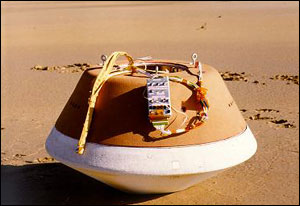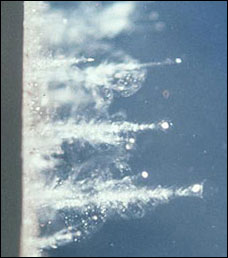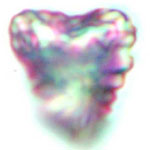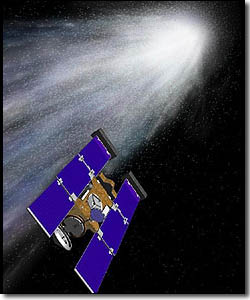NASA shows off Comet particles
Posted By RichC on March 14, 2006
 NASA’s Stardust space capsule returned to earth on January 15, 2006, after investigating the Comet Wild 2. It captured particles of dust from the comets tail in a special strong but lightweight gel. Most of us were taught that comets were ice, dust and gas, but scientists gathered at the Johnson Space Center in Houston discovered minerals formed by intense heat as well, which suggests to them that our comets may originally come from close to the sun.
NASA’s Stardust space capsule returned to earth on January 15, 2006, after investigating the Comet Wild 2. It captured particles of dust from the comets tail in a special strong but lightweight gel. Most of us were taught that comets were ice, dust and gas, but scientists gathered at the Johnson Space Center in Houston discovered minerals formed by intense heat as well, which suggests to them that our comets may originally come from close to the sun.
 The comet ‘Wild 2’ is about 3 miles wide and passes nearest the earth while in its orbit closest to Mars. Its eliptical path then sends it zipping well out into our solar system before bringing it back around the sun again. When we visually see the comet, it is a bright streaking lump followed by a long gaseous tail that grows as it nears the sun and shrinks as it heads back off into space. Comets can have tails as long as 62 million miles, although Wild 2 is much smaller. They travel at speeds faster than a bullet travels, making intersection for Stardust, the space capsule, a critical calculation. The spacecraft had to travel at 13,000 mph to pass within 160 miles of the core of the comet which is traveling at 10,000 mph.
The comet ‘Wild 2’ is about 3 miles wide and passes nearest the earth while in its orbit closest to Mars. Its eliptical path then sends it zipping well out into our solar system before bringing it back around the sun again. When we visually see the comet, it is a bright streaking lump followed by a long gaseous tail that grows as it nears the sun and shrinks as it heads back off into space. Comets can have tails as long as 62 million miles, although Wild 2 is much smaller. They travel at speeds faster than a bullet travels, making intersection for Stardust, the space capsule, a critical calculation. The spacecraft had to travel at 13,000 mph to pass within 160 miles of the core of the comet which is traveling at 10,000 mph.
 As far as comets go, Wild 2 ellipse around the sun is shorter than most. It will be back again in 6.39 years unlike the famous Haleys comet which return every 100 years. Although the age of comet dust is debated, many believe that the dust is from 4.5 billion years ago and that comets may have delivered the water that led to life on Earth. Another interesting component in comets is that they are loaded with carbon, an element essential to life.
As far as comets go, Wild 2 ellipse around the sun is shorter than most. It will be back again in 6.39 years unlike the famous Haleys comet which return every 100 years. Although the age of comet dust is debated, many believe that the dust is from 4.5 billion years ago and that comets may have delivered the water that led to life on Earth. Another interesting component in comets is that they are loaded with carbon, an element essential to life.
 Scientists chose to send Stardust to ‘Wild ‘ primarily because it has just recently entered an orbit that takes it close to the sun, which they indicate ‘bakes’ the surface of comets. Wild 2 is believed to have more of its material perserved because of this and therefore the dust more apt to offer better material in which to study. In 1974 Wild 2 neared the large mass of Jupiter which swung the comet through gravitational pull on a course taking it closer to the sun according to calculations, since it wasn’t actually discovered until 1978.
Scientists chose to send Stardust to ‘Wild ‘ primarily because it has just recently entered an orbit that takes it close to the sun, which they indicate ‘bakes’ the surface of comets. Wild 2 is believed to have more of its material perserved because of this and therefore the dust more apt to offer better material in which to study. In 1974 Wild 2 neared the large mass of Jupiter which swung the comet through gravitational pull on a course taking it closer to the sun according to calculations, since it wasn’t actually discovered until 1978.
(Wild 2 was named for Paul Wild, a Swiss astronomer who first spotted the comet in January 1978.)
Comments